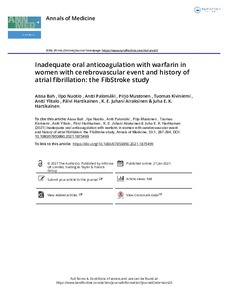Inadequate oral anticoagulation with warfarin in women with cerebrovascular event and history of atrial fibrillation: the FibStroke study
Hartikainen Juha EK; Kiviniemi Tuomas; Airaksinen KE Juhani; Bah Aissa; Nuotio Ilpo; Ylitalo Antti; Mustonen Pirjo; Hartikainen Päivi; Palomäki Antti
Inadequate oral anticoagulation with warfarin in women with cerebrovascular event and history of atrial fibrillation: the FibStroke study
Hartikainen Juha EK
Kiviniemi Tuomas
Airaksinen KE Juhani
Bah Aissa
Nuotio Ilpo
Ylitalo Antti
Mustonen Pirjo
Hartikainen Päivi
Palomäki Antti
TAYLOR & FRANCIS LTD
Julkaisun pysyvä osoite on:
https://urn.fi/URN:NBN:fi-fe2021042822928
https://urn.fi/URN:NBN:fi-fe2021042822928
Tiivistelmä
Background: Women with atrial fibrillation (AF) may be treated less actively with oral anticoagulation (OAC) than men.Patients and methods: We assessed sex differences in the implementation of stroke risk stratification with CHADS(2) and CHA(2)DS(2)-VASc scores and reasons not to use OAC in 1747 AF patients suffering their first cerebrovascular event after the AF diagnosis.Results: Women were older and had more often a high stroke risk (CHADS(2)/CHA(2)DS(2)-VASc >= 2) than men (p < .001). On admission, 46.4% of women and 48.2% of men were on OAC with no sex difference (p = .437). However, of patients without OAC, 74.4% of women and 49.5% of men should have been on OAC based on CHADS(2)/CHA(2)DS(2)-VASc >= 2 (p < .001). Conversely, 34.8% of men and 17.5% of women on OAC had a low or moderate risk (CHADS(2)/CHA(2)DS(2)-VASc 0-1, p < .001). A valid reason to omit OAC was reported in 38.6% of patients and less often in women (p < .001).Conclusions: OAC was underused in high-risk AF patients, particularly women, but prescribed often in men with low or moderate stroke risk. Reasons for omitting OAC treatment were poorly reported, particularly for women.
Kokoelmat
- Rinnakkaistallenteet [19207]
